Part 1: Fentanyl addiction fuels underground shoplifting economy in LA’s MacArthur Park
This project was originally published in Los Angeles Daily News with support from our 2023 California Health Equity Fellowship.
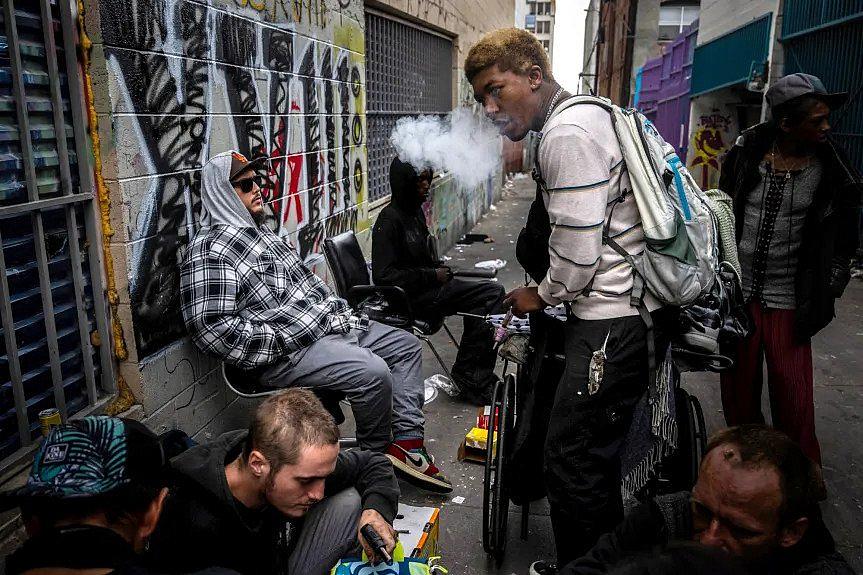
Elliot, 24, bottom left, who says he began using heroin at age 12 and is addicted to fentanyl, hangs out in an alley by MacArthur Park near downtown Los Angeles where drug use is rampant.
Photo by Sarah Reingewirtz, Los Angeles Daily News/SCNG
Fifty dollars a day. That’s how much Elliot, a 24-year-old living on the streets of MacArthur Park, says he must come up with to avoid fentanyl withdrawals, a debilitating pain that “feels like dying.”
For someone with no phone, no home, no job and no more possessions than can fit into a backpack, this is no easy task. So Elliot, like many others battling addiction, makes money for fentanyl by selling shoplifted goods to street vendors around MacArthur Park.

Elliot, 24, “boosts” for breakfast. He is addicted to fentanyl and lives on the streets by MacArthur Park.
Photo by Sarah Reingewirtz, Los Angeles Daily News/SCNG
The Southern California News Group interviewed Elliot, dozens of other people who use fentanyl, business owners, residents, LAPD personnel, homeless outreach workers, and medical professionals over several months, discovering how the intertwined crises of homelessness, addiction and petty theft have made MacArthur Park an epicenter of a deadly epidemic.
Overdoses are a daily occurrence in the area, says Councilmember Eunisses Hernandez, who represents the neighborhood.
“When we think about the epidemic of overdoses, of fentanyl use, of sales,” she says, “MacArthur Park is ground zero.”
At a county level, the synthetic opioid was responsible for 1,504 fatal overdoses in 2021, a 1,280% increase from 109 overdoses in 2016, according to the most-recent data available from the county’s Department of Public Health.
I could kick heroin; kicking (fentanyl), not going to happen. Quitting cold turkey would physically kill me.” Elliot, who uses fentanyl
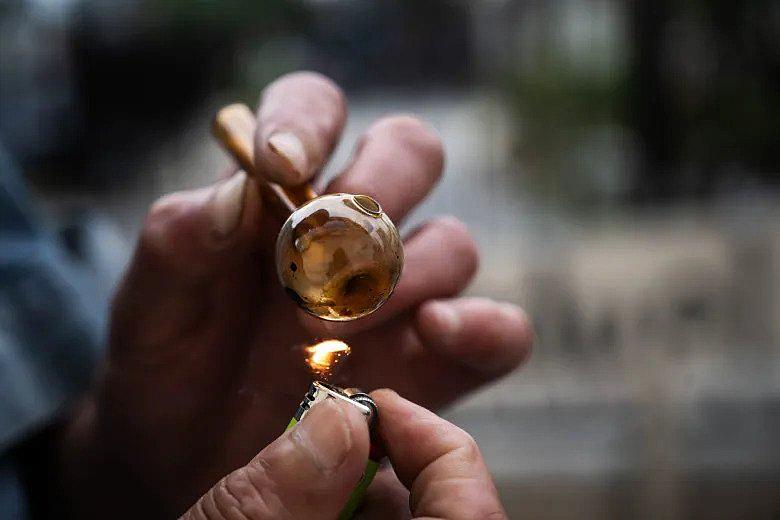
A fentanyl user smokes the drug in a Los Angeles alley near MacArthur Park.
Photo by Sarah Reingewirtz, Los Angeles Daily News/SCNG
Fentanyl is 50 times more potent than heroin by weight, according to the Centers for Disease Control and Prevention.
“Imagine comparing a very light beer with 100% grain alcohol,” says Joseph Friedman, a drug researcher at UCLA’s David Geffen School of Medicine. “It’s that degree of magnitude of intensity in terms of the psychoactive effects.”
Its effects also wear off quicker.
While a heroin high lasts about six hours, people who use fentanyl frequently may feel withdrawals within two to three hours of smoking the drug, says Ricky Bluthenthal, public health professor at USC’s Keck School of Medicine. And there’s evidence to suggest its withdrawals are more painful than those from heroin, he adds.
“I have tried (quitting fentanyl),” Elliot says. “I thought kicking heroin was bad, uh-uh, no. I could kick heroin; kicking this, not going to happen. Quitting cold turkey would physically kill me.”
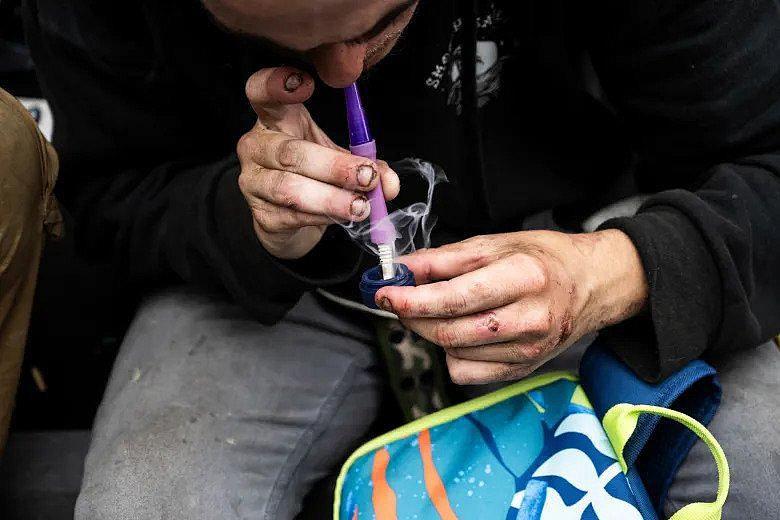
Elliot smokes fentanyl in a Los Angeles alley near MacArthur Park. Elliot began using heroin at age 12 in Toronto, Canada.
Photo by Sarah Reingewirtz, Los Angeles Daily News/SCNG
Racing against a constant countdown to withdrawals — with symptoms that include fever, vomiting, diarrhea and bone pain — and faced with limited access to substance use treatment, people often resort to extreme means to get fentanyl.
Shoplifted goods market feeds addiction
Many unhoused people shoplift goods from stores locally and across the city to make money for drugs, says LAPD Detective Stephen Beerer. People on the streets refer to this process as “boosting.”
People sell the stolen goods to street vendors around MacArthur Park, who “fence” — or resell — the stolen goods at a below-market price, Beerer says. Not all vendors are part of this trade and some sell homemade food or legally acquired products.
“I’ve seen a pretty significant uptick (in shoplifting) this year, especially at the beginning of this year with the addition of a new Target store in the area,” Beerer says. “We saw a lot more crime, a lot more shoplifting and a lot more fencing operations at the park.”
Drug use has become so blatant that the LAPD now brings officers from all over the city to MacArthur Park to train as drug recognition experts. During training, officers arrest people who appear to be under the influence of a controlled substance and test them to ensure they correctly identified the intoxication.
“It is probably one of the highest fentanyl user areas in the city,” says LAPD Sgt. Greg Fuqua. “Most of our officers will go into the field and within an hour and a half they have eight arrests because it’s (drug use) just so prevalent and so visible out in the community.”
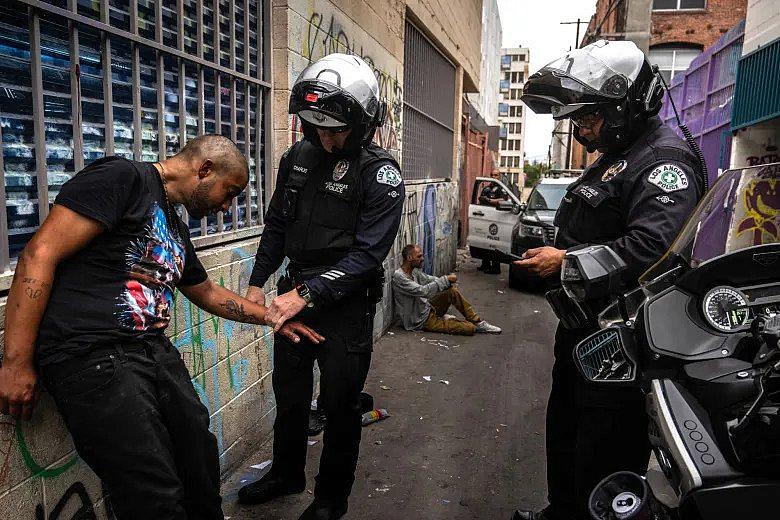
LAPD officers from the Drug Recognition Expert task force stop and check the pulse of a man suspected to be under the influence of fentanyl near MacArthur Park.
Photo by Sarah Reingewirtz, Los Angeles Daily News/SCNG
The spike in fentanyl use is taking a toll on the neighborhood of Westlake surrounding the park.
This 2.75-square-mile community is home to more than 116,000 people, making it one of the most densely populated neighborhoods in Los Angeles, according to the U.S. census. More than 70% of residents are Hispanic or Latino, about 50% were born outside of the U.S., and almost one in three live below the poverty line.
The park itself is a gem of a neighborhood resource. It features a lake, a soccer pitch, a playground and an amphitheater that is home to a much-loved free concert series. But residents’ enjoyment of it has long been impacted by a history of drug use, gang violence and homelessness.
Now, the fentanyl and “boosting” epidemics bring fresh challenges.
“I’ve seen an increase of homeless people in the area, and there are too many people who are using drugs,” Magdalena Carrio, a 12-year MacArthur Park resident and mother of four, says in Spanish. “We usually don’t come to this park for those exact reasons.”
“Boosting” an illegal, dangerous full-time job
People who use fentanyl pay a heavy price for engaging in the all-consuming hustle of “boosting.” It distracts from their physical health needs and creates a barrier to accessing services and housing.
Elliot says he makes four to five boosting trips a day — stealing from shops all over the city to make enough money to “get well” — a process he calls “work.”
One morning in June, for example, Elliot rides the A-line to boost all the way out in Long Beach. Along the way, he nods his head to the beats of Tupac coming from a fellow rider’s speaker and throws up a “W” hand sign — for Westside — as the train passes through Compton, where he spent part of his childhood.
“By the time they have secured their drug, maybe half a day has gone by. They haven’t even eaten really, haven’t really done any basics to take care of themselves, because they’ve put all their energy and effort into being around it.”
Rita Richardson, outreach coordinator for LA DOOR program
Elliot is a huge fan of the 1990s wave of West Coast rappers. Before becoming homeless, he mixed music and dreamed of working in the industry. Now he gets robbed too frequently to hold onto a phone, so rare moments like this are the only time he hears his favorite tunes.

Elliot trades “boosted” energy drinks to Alejandro for a hit of fentanyl.
Photo by Sarah Reingewirtz, Los Angeles Daily News/SCNG
Elliot arrives back in MacArthur Park several hours later, lugging heavy bags of coloring books, energy drinks and electronics boosted from a discounted goods store. He sweats heavily, scrambling to find a vendor to purchase his stolen goods before his withdrawals worsen.
“You’re constantly making trips,” he says. “You’re pretty much so goddamn sick (due to drug withdrawal) by the end of your trips that you just want to get your stuff (fentanyl) and kick back for the rest of the day.”
Rita Richardson, who helps lead a street outreach team in MacArthur Park under the L.A. city attorney program LA DOOR (Diversion, Outreach and Opportunities for Recovery), says people who use fentanyl are an especially hard population to connect with services, because their energy is consumed by their pursuit of the substance.
“By the time they have secured their drug, maybe half a day has gone by,” she says. “They haven’t even eaten really, haven’t really done any basics to take care of themselves, because they’ve put all their energy and effort into being around it.
“It leaves little room for anything else.”
Over time, boosting, drug use and homelessness take a serious toll on people’s health.
“The longer they are on fentanyl, the worse their appearance is, the worse that they take care of themselves,” Richardson says. “Fentanyl supersedes the pain and they will use more to override the need to go get medical care.”
“There is no rope in the well for them to climb out”
Awalk down the alleyway behind Alvarado Street in MacArthur Park paints a jarring picture of this health care crisis.
People smoke next to piles of discarded food, crumpled boxes and empty butane lighters. The smell of burning tin foil – a cheap and popular smoking method – fills the air. Many people have swollen legs, skin infections and open wounds, a consequence of limited access to health care or showers while living on the streets.
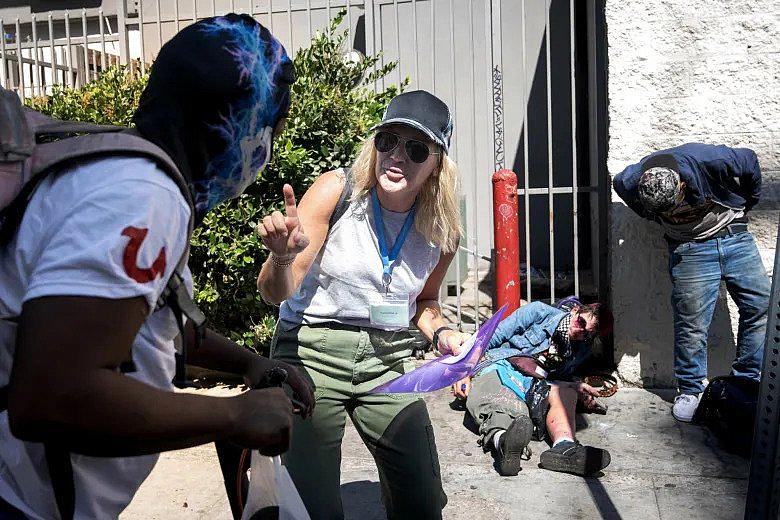
Jennifer Haid, who founded nonprofit Humankind LA, does outreach in the MacArthur Park area to help those living on the streets obtain housing.
Photo by Sarah Reingewirtz, Los Angeles Daily News/SCNG
Outreach worker Jennifer Haid, who spends four days a week helping people living around MacArthur Park through her nonprofit Humankind LA, says fentanyl addiction consistently comes between her clients and their goals.
“When there is one thing in the world that matters and your brain is screaming to you that’s all that matters, are you going to get in the car with Jen and go to the DMV to get a new ID?” Haid says. “Maybe eventually, but it could take months before that moment hits when I’m here and I’m able, and you’re here and you’re able.”
Haid founded Humankind LA in 2020 because she saw a shortage of services offered to the homeless population in MacArthur Park. She has about 100 regular clients in the area, more than 90% of whom, she estimates, are addicted to fentanyl.
“It’s too hard to be out here and be clean; I need to do a program where I’m in a safe environment.”
Jennifer, who uses fentanyl and lives around MacArthur Park
Accessing substance use treatment and other resources is a struggle for her clients. The majority cannot hold onto a phone, an ID or documents and therefore can’t stay in touch with most outreach workers or register for housing.
“There is no rope in the well for them to climb out,” Haid says, “so how the heck are they going to get out, even if they want to get out?”
There are ongoing efforts to address the challenges her clients face.
Mayor Karen Bass declared a state of emergency to confront the homeless crisis and has rapidly moved people off the street through her “Inside Safe” program. Before that, the city and county of Los Angeles pumped millions of dollars into initiatives to solve the intertwined issues of homelessness, mental illness and substance use.
But in MacArthur Park, services have neither caught up with the scale of people experiencing homelessness nor adapted to the unique challenges posed by the new threat of fentanyl.
Hernandez, the area’s councilmember, says she’s working to bring more resources to the area. She seeks to launch a mobile overdose prevention team and open a “harm reduction center” offering wound care, sterile drug supplies, food, clothes, a place to rest and service referrals. But first she must secure funding and a lease for the center.
For the time being, though, many people don’t know where to turn for help.
Some, like Elliot, are consumed by the daily struggle of homelessness and addiction — and can’t imagine quitting fentanyl at this time.
Others are actively interested in treatment, but don’t know how to enroll in a rehab program, how to pay for it or where they would live after that program concludes.
“It’s too hard to be out here and be clean; I need to do a program where I’m in a safe environment,” says Jennifer, who lives around MacArthur Park. “I would definitely do it. What I struggle with is keeping a phone out here. I’ve had a million phones, but they get stolen or I sell them for drugs.”
Jennifer says she would get treated at the center where she successfully detoxed from heroin several years ago. But, she says, it rarely has open beds and she worries they won’t be able to contact her when one opens.
Fentanyl floods streets, overtakes other opioids
Fentanyl first arrived in Los Angeles around 2016 and its use began to take off in 2019, with the majority of the supply coming from Mexico and China, says Chelsea Shover, health services researcher and assistant professor-in-residence at UCLA’s David Geffen School of Medicine.
Fentanyl has flooded the street drug market. Besides its powder form, it is found in cocaine, counterfeit pain pills and even methamphetamine, Shover says.

Denver smokes fentanyl in the alley.
Photo by Sarah Reingewirtz, Los Angeles Daily News/SCNG
“People get exposed to it, whether on purpose or not, and then because it’s a pretty addictive drug and also it doesn’t last very long, you have to use it more often and in higher amounts to get the same effect,” Shover says. “It’s really hard to stop.”
Many people who currently or formerly used heroin or opioid pills eventually turn to fentanyl, not necessarily because of a desire to seek it out, but simply because it’s the most readily available opioid, USC researcher Ricky Bluthenthal says.
This was the case for Elliot, who says his late parents were both addicted to heroin. Elliot says he first tried heroin at just 12 years old.
He is well aware of the dangers of using opioids. He lost one of his brothers to an overdose. But having used opioids on-and-off for more than a decade, Elliott says, he feels powerless against the potency of fentanyl.
“I know it killed one of my family members,” Elliot says, “but I’ve done opiates for so long and I depend on them.”
He tears up at the thought of his late brother.
“It sucks,” he says, “to have to admit I’m doing something that killed someone I care about deeply.”
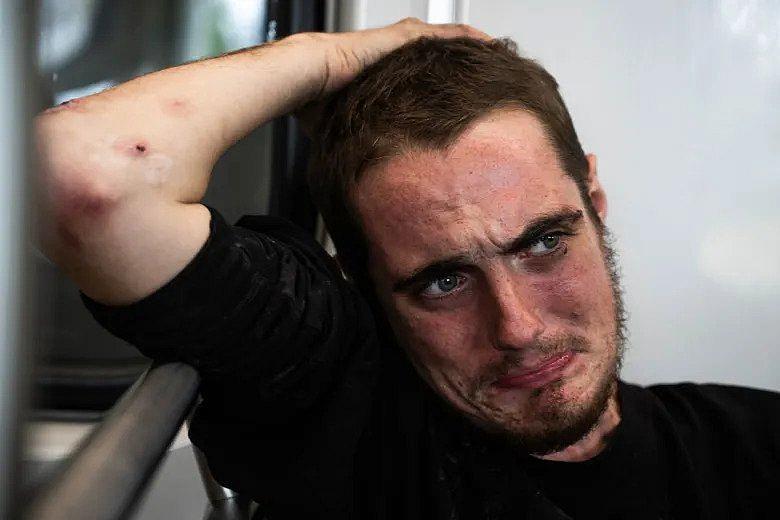
While riding the LA Metro to Long Beach to “boost” Elliot sheds tears as he talks about his family.
Photo by Sarah Reingewirtz, Los Angeles Daily News/SCNG


